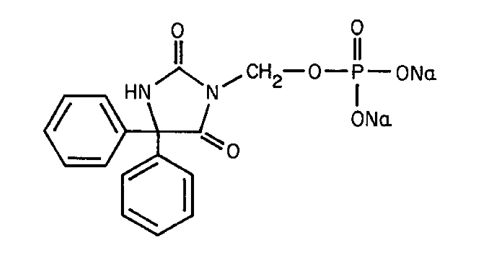Fosphenytoin Sodium
» Fosphenytoin Sodium contains not less than 98.0 percent and not more than 102.0 percent of C16H13N2Na2O6P, calculated on the anhydrous basis.
Packaging and storage—
Preserve in tight containers.
USP Reference standards  11
11 —
—
USP Fosphenytoin Sodium RS.
USP Phenytoin RS.
USP Phenytoin Related Compound A RS .
.
USP Phenytoin Related Compound B RS.
USP Fosphenytoin Sodium RS.
USP Phenytoin RS.
USP Phenytoin Related Compound A RS
 .
.
USP Phenytoin Related Compound B RS.
Identification—
B:
The retention time of the major peak in the chromatogram of the Assay preparation corresponds to that in the chromatogram of the Standard preparation, as obtained in the Assay.
C:
It meets the requirements of the tests for Sodium  191
191 .
.
pH  791
791 :
between 8.5 and 9.5, in a solution containing 75 mg per mL.
:
between 8.5 and 9.5, in a solution containing 75 mg per mL.
Water, Method I  921
921 :
between 21.7% and 25.7%.
:
between 21.7% and 25.7%.
Heavy metals, Method I  231
231 :
0.002%.
:
0.002%.
Related compounds—
Buffer solution, Mobile phase, and Chromatographic system—
Proceed as directed in the Assay.
Standard solution—
Dissolve accurately weighed quantities of USP Phenytoin Related Compound A RS, USP Phenytoin Related Compound B RS, and USP Phenytoin RS in Mobile phase; and dilute quantitatively, and stepwise if necessary, with Mobile phase to obtain a solution having known concentrations of about 3.0 µg per mL, 3.0 µg per mL, and 1.5 µg per mL, respectively.
Test solution—
Transfer about 150 mg of Fosphenytoin Sodium, accurately weighed, to a 50-mL volumetric flask, dissolve in and dilute with Mobile phase to volume, and mix.
Procedure—
Separately inject equal volumes (about 20 µL) of the Standard solution and the Test solution into the chromatograph, record the chromatograms for not less than six times the retention time of the major peak, and measure all the peak responses. Calculate the percentage of phenytoin, phenytoin related compound B, and phenytoin related compound A, if present, in the portion of Fosphenytoin Sodium taken by the formula:
100(CS / CU)(ri / rS)
in which CS is the concentration, in mg per mL, of the USP Reference Standard of the respective impurity in the Standard solution; CU is the concentration, in mg per mL, of Fosphenytoin Sodium in the Test solution; and ri and rS are the peak responses for each impurity obtained from the Test solution and the Standard solution, respectively: not more than 0.1% of phenytoin is found; not more than 0.1% of any other impurity is found; and not more than 0.5% of total impurities is found. [note—Use the peak area and concentration of USP Phenytoin RS in the Standard solution as rS and CS, respectively, to calculate the percentage of the unknown impurities.]
Assay—
Buffer solution—
Dissolve 6.80 g of monobasic potassium phosphate and 30 mL of 0.5 M dodecyltriethylammonium phosphate in 900 mL of water, adjust with 1.5 M phosphoric acid to a pH of about 5.0, dilute with water to 1000 mL, mix, and filter.
Mobile phase—
Prepare a filtered and degassed mixture of Buffer solution and acetonitrile (13:7). Make adjustments if necessary (see System Suitability under Chromatography  621
621 ).
).
Standard preparation—
Dissolve an accurately weighed quantity of USP Fosphenytoin Sodium RS in Mobile phase, and dilute quantitatively, and stepwise if necessary, with Mobile phase to obtain a solution having a known concentration of about 0.15 mg per mL.
Assay preparation—
Transfer about 150 mg of Fosphenytoin Sodium, accurately weighed, to a 50-mL volumetric flask, dissolve in and dilute with Mobile phase to volume, and mix. Transfer 5.0 mL of this solution to a 100-mL volumetric flask, dilute with Mobile phase to volume, and mix.
Chromatographic system (see Chromatography  621
621 )—
The liquid chromatograph is equipped with a 214-nm detector and a 3.9-mm × 15-cm column that contains 5-µm packing L1. The flow rate is about 1 mL per minute. Chromatograph the Standard preparation, and record the peak responses as directed for Procedure: the relative retention times are about 0.5 for phenytoin and 1.0 for fosphenytoin sodium; the column efficiency determined from fosphenytoin sodium is not less than 5000 theoretical plates; the tailing factor for the fosphenytoin sodium peak is not more than 1.6; and the relative standard deviation for replicate injections is not more than 0.5%.
)—
The liquid chromatograph is equipped with a 214-nm detector and a 3.9-mm × 15-cm column that contains 5-µm packing L1. The flow rate is about 1 mL per minute. Chromatograph the Standard preparation, and record the peak responses as directed for Procedure: the relative retention times are about 0.5 for phenytoin and 1.0 for fosphenytoin sodium; the column efficiency determined from fosphenytoin sodium is not less than 5000 theoretical plates; the tailing factor for the fosphenytoin sodium peak is not more than 1.6; and the relative standard deviation for replicate injections is not more than 0.5%.
Procedure—
Separately inject equal volumes (about 20 µL) of the Standard preparation and the Assay preparation into the chromatograph, record the chromatograms, and measure the responses for the major peaks. Calculate the quantity, in mg, of C16H13N2Na2O6P in the portion of Fosphenytoin Sodium taken by the formula:
1000C(rU / rS)
in which C is the concentration, in mg per mL, of USP Fosphenytoin Sodium RS in the Standard preparation; and rU and rS are the peak responses obtained from the Assay preparation and the Standard preparation, respectively.
Auxiliary Information—
Please check for your question in the FAQs before contacting USP.
Chromatographic Column—
| Topic/Question | Contact | Expert Committee |
| Monograph | Ravi Ravichandran, Ph.D.
Senior Scientist 1-301-816-8330 |
(MDPP05) Monograph Development-Psychiatrics and Psychoactives |
| Reference Standards | Lili Wang, Technical Services Scientist 1-301-816-8129 RSTech@usp.org |
USP32–NF27 Page 2454
Pharmacopeial Forum: Volume No. 34(2) Page 270
Chromatographic columns text is not derived from, and not part of, USP 32 or NF 27.
